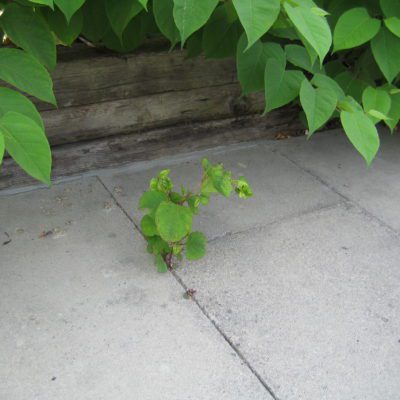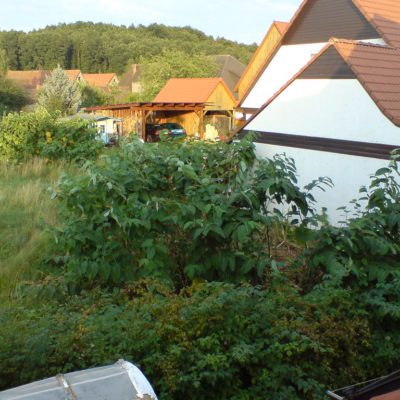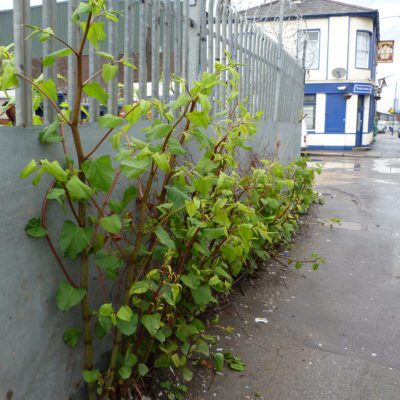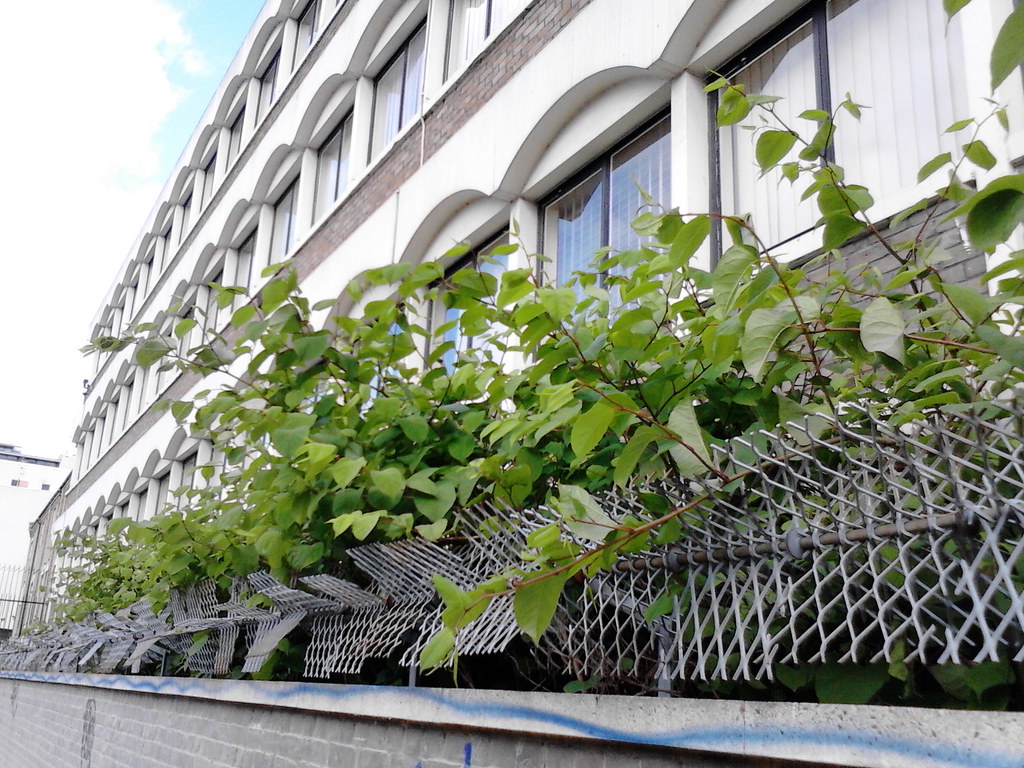What Damage Does Japanese Knotweed Do?
Over the last decade, Japanese knotweed has developed a reputation for being one of the most damaging and aggressive, invasive plants to be currently blighting the country and many don’t even know how to get rid of Japanese knotweed.
However, despite the plant’s fearsome reputation, there can still be some confusion as to what it actually does. The first question many homeowners or sellers might have when first discovering a Japanese knotweed infestation is: will this plant damage my property?
This article will explain what Japanese knotweed damage looks like, how likely it is to damage your property, the wider environmental impact it may have and how it could damage property owners financially.
The examples cited here should be considered within the larger context of Japanese knotweed cases, this plant can thrive in all sorts of environments, but no single infestation is the same.
Uncertain if you have Japanese Knotweed? Check out our Japanese knotweed image gallery or see our Japanese Knotweed identification guide.
We can answer your Japanese knotweed questions!
Talk To UsContents
What damage does Japanese knotweed do to a house?
Japanese Knotweed can cause damage to houses including:
- infiltrating outbuilding foundations with weak foundations
- root system growing through paving, tarmac, building foundations and flood defences
- Japanese knotweed’s damaging effects on houses can also devalue properties by up to 15%
Knotweed is notable for growing up to 10cm a day during the summer relentlessly. In addition to growing above ground, knotweed’s rhizomes can spread beneath the ground. The RICS has suggested that rhizomes can grow as much as 7-metres from the plant’s stands [2], however, research conducted by the University of Leeds [3] has suggested that this may be overestimating the capabilities of the plant.

Japanese Knotweed growing through garden paving. Photo: Flickr – https://creativecommons.org/licenses/by-sa/2.0/ – © Gordon Joly – https://www.flickr.com/photos/loopzilla/172504211
Is Japanese knotweed dangerous?
Japanese knotweed is not poisonous, nor does it pose any physical danger to animals or people. The plant does, however, pose a threat to native plants that are not as well equipped to compete with this foreign element.
The environmental impact that this plant has on our own wildlife is often overlooked in favour of the financial costs of treating it. When the plant is allowed to thrive on public waterways or on disused industrial lots, it can quickly stifle the growth of any other plants growing nearby.
What can Japanese Knotweed damage?
Japanese knotweed has been known to cause damage to physical property, the environment [4] and to the finances of those unlucky enough to own property affected by the plant.
In minor cases, Japanese knotweed may cause no damage to physical property at all, however, homeowners will still need to pay to remove the plant.
In the worst-case scenarios, however, Japanese knotweed can take advantage of weaknesses in structures and lead to expensive repairs, on top of the costs to remove the plant.
How does Japanese knotweed cause damage?
When left to flourish, a Japanese knotweed infestation can amass a large above-ground canopy which may exert pressure on nearby walls or fences [5]. Whilst the plant’s stands above ground may seem like the biggest threat, the rhizome root system beneath the ground is likely to cause more damage in the long term.
Individual roots can grow to 20cm in diameter and can conglomerate into bulky crowns which have the potential to slowly deform concrete and block drains. Attempting to hack away at these rhizomes can also lead to the plant further spreading, as the plant can grow from rhizomes fragments as small as a fingernail.

Japanese Knotweed encroaching fence. Photo: Flickr – https://creativecommons.org/licenses/by/2.0/ – © dankogreen – https://www.flickr.com/photos/26597493@N08/2489762608
Can Japanese knotweed damage buildings?
The damage that Japanese knotweed can cause to buildings ranges from minor exploitation of old brickwork or concrete to full-blown subsidence.
Subsidence as a result of a Japanese knotweed infestation is usually only possible when a property is built on shrinkable clay soils [6]. Fortunately, these ‘heavy clay soils aren’t common throughout the UK.
The plant’s ability to grow through concrete and tarmac has been overstated by some removal experts and unscrupulous media sources. With that being said, there’s enough photographic evidence on the internet to support the claims that, if unattended to, Japanese knotweed can cause damage to property.
Can Japanese knotweed damage foundations?
Japanese knotweed has been known to disturb the foundations of buildings. The most notable case of this was reported by the BBC [7] in 2011. After discovering Japanese knotweed growing in their back garden, a couple in Hertfordshire were alarmed to discover the plant growing through the skirting boards in their dining room.
After Broxbourne Borough Council sent an environmental specialist to inspect the property, the couple was advised to contact a solicitor. Experts estimated their property’s value had dropped from £305,000 to £50,000, and that their Japanese knotweed infestation made their home impossible to sell.
Whilst the foundations of the property were not necessarily damaged by the Japanese knotweed, the infestation beneath their home made paying for removal a costly prospect. Experts informed them that the only way of ensuring that the plant was completely removed from the property would be by demolishing the entire structure and digging out the 10ft of contaminated soil beneath.
It should be stressed that this is a rare case of subsidence caused by Japanese knotweed. In the Guidance Notes on Japanese knotweed and residential property, published by the RICS in 2022, it was stated that Japanese knotweed is less likely to cause structural damage to property than most common woody shrubs, such as buddleia.
Can Japanese knotweed grow through concrete?
There is some photographic evidence to suggest that Japanese knotweed can grow through concrete [8], however, this has only been noted to happen in scenarios where the infestation is particularly bad and the construction work is particularly shoddy.
In extreme cases, Japanese knotweed is also known to disrupt independent structures such as garden sheds, greenhouses, and fences. The plant can also slowly break through poorly built brickwork, paving and tarmac.

Japanese Knotweed growing through tarmac.
Photo: Flickr – https://creativecommons.org/licenses/by-sa/2.0/ – © Gordon Joly – https://www.flickr.com/photos/24987280@N00/6979035552
What does Japanese knotweed do to the value of a house?
Japanese knotweed does not necessarily ‘write off’ a house. How the plant affects the property will depend on the severity of the infestation and how close the plants are to the buildings.
Although it’s possible to find evidence of Japanese knotweed literally breaking through into homes, this is rare and usually the result of a combination of poor building maintenance and a particularly aggressive infestation.
Japanese knotweed’s predominant effect on a house is financial. In the average case of Japanese knotweed discoveries, the value of the property is diminished between 5-15% [9].
Paul Raine BSc FRICS MEWI from Expert Surveyors said:
“In most cases, Japanese Knotweed will reduce the value of your home for the period of the treatment and for several years after. Each case is different and depends on a combination of 10 key factors.
There is a real stigma associated with Japanese Knotweed and most willing buyers would much rather buy a house without an infestation of Japanese Knotweed (or history of an infestation of Japanese Knotweed). Therefore, it follows that in most cases willing buyers will only pay below market value if a property is infested with Japanese Knotweed.”
We can answer your Japanese knotweed questions!
Talk To UsCan Japanese knotweed damage the environment?
Japanese knotweed has a number of physical characteristics which has made it particularly troublesome in the UK, chief of these is the incredible speed that it grows at.
Whilst it does die back during winter, its peak growth during the summer can see it growing up to 10cm a day and 70cm in the space of a week. Coupled with its incredible resilience, it’s unsurprising that the government has labelled Japanese knotweed as an invasive threat.
Not only does it grow fast, but Japanese knotweed also spreads at an alarming rate. Although the plant does not propagate in the usual fashion in the UK (only the female of the species was imported to Britain in the 19th century [14]), it spreads via an underground root system, comprised of rhizomes.
Not only are these roots fast-growing, but they’re also capable of growing from the smallest of fragments, which was one of the driving factors behind the government making it a criminal offence to move soil that has been contaminated with the plant.
Unfortunately, despite the control measures that have been put in place, the spread of Japanese knotweed has continued to the point where the plant is estimated to an infestation for every 10 square kilometres in Britain, according to PlantTracker [15] who produced data that helped build a map showing the spread of Japanese knotweed in the UK.
If you’ve identified Japanese knotweed on your land, or are currently locked in a dispute related to it, then as Japanese knotweed specialists we may be able to help. Give us a call or send us a message using the contact form, and we’ll get back to you with guidance on how best to proceed.
References
[1] Japanese knotweed – RHS – https://www.rhs.org.uk/advice/profile?pid=218
[2] Japanese knotweed and residential property (Information Paper) – RICS – https://www.rics.org/globalassets/rics-website/media/upholding-professional-standards/sector-standards/real-estate/japanese-knotweed-and-residential-property-1st-edition.pdf
[3] Japanese knotweed (Fallopia japonica): An analysis of capacity to cause structural damage (compared to other plants) and typical rhizome extension – Mark Fennell, Max Wade, Karen L Bacon – https://peerj.com/preprints/27023/
[4] Prevent Japanese knotweed from spreading – Gov.uk – https://www.gov.uk/guidance/prevent-japanese-knotweed-from-spreading
[5] Bringing the roof down: The facts about structural damage by Japanese knotweed – Nic Seal – https://www.linkedin.com/pulse/bringing-roof-down-facts-structural-damage-japanese-knotweed-nic-seal
[6] Japanese knotweed is no more of a threat to buildings than other plants – Karen Bacon – https://leaf.leeds.ac.uk/news/japanese-knotweed-is-no-more-of-a-threat-to-buildings-than-other-plants/
[7] Japanese knotweed invasion causes Hertfordshire home price drop – BBC – https://www.bbc.co.uk/news/uk-england-beds-bucks-herts-15461880
[8] Image – Japanese knotweed concrete – Cornwall Live – https://i2-prod.cornwalllive.com/news/cornwall-news/article749769.ece/ALTERNATES/s1200/Japanese-knotweed-concrete.jpg
[9] Weeds on the web: conflicting management advice about an invasive non‐native plant – Beth S. Robinson, Richard Inger, Sarah L. Crowley, Kevin J. Gaston – https://besjournals.onlinelibrary.wiley.com/doi/full/10.1111/1365-2664.12712
[10] Treating Japanese Knotweed on the Olympic Park – Learning Legacy [Archive] – https://webarchive.nationalarchives.gov.uk/20130228084356/http://learninglegacy.london2012.com/publications/treating-japanese-knotweed-on-the-olympic-park.php?stylesheet=normal
[11] Japanese knotweed – Identification, Distribution, Edibility – Galloway Wild Foods – https://gallowaywildfoods.com/japanese-knotweed-identification-distribution-edibility/
[12] Kenneth McRae killed wife Jane and then himself over knotweed fears – BBC – https://www.bbc.co.uk/news/uk-england-birmingham-34515446
[13] Buying or selling a property affected by Japanese knotweed? – On The Market – https://www.onthemarket.com/content/buying-or-selling-a-property-affected-by-japanese-knotweed/
[14] Japanese Knotweed – Dr John Bailey, University of Leeds – https://www2.le.ac.uk/departments/genetics/people/bailey/res
[15] Distribution of Japanese Knotweed reports – PlantTracker – https://www.planttracker.org.uk/map/knotweed

